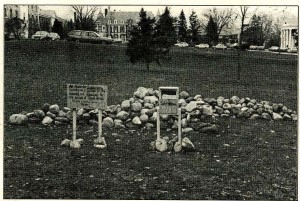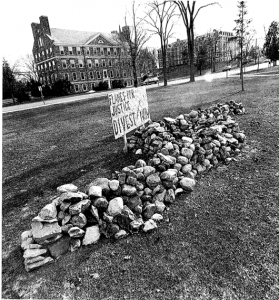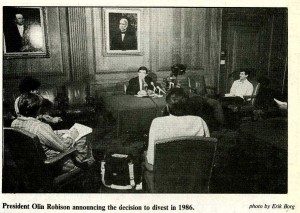In the 1980s, Middlebury College was one of 155 campuses that eventually divested from businesses doing business in South Africa. Though the impetus for the push for Middlebury to divest originally came from faculty, students played an active role in the movement as well. In April 1981, the faculty voted overwhelmingly in favor of a motion urging the Board of Trustees to divest from companies with holdings in South Africa. Later that same year, student interest was building, but the majority of students were opposed to divestment.
However, by 1985, student support had grown, with two student groups leading the cause: the Students Against Apartheid (SAA) and the Armadillos, a group named after former Nicaraguan Minister of Culture Ernesto Cardenal’s poem “Ecologia.” In October 1985, SAA sponsored a series of events in attempts to demonstrate the difficulties faced by black South Africans, and gathered 1000 student signatures on a petition, in hopes of influencing the Board of Trustees’ meeting the following January.
The Armadillos’ tactic was more visible, made in an effort to increase student awareness and concern about the issue of apartheid. In the November 8, 1985 issue of the Campus newspaper, the Armadillos announced their plan to construct the wall, citing the shantytown built by UVM students as inspiration to do “something physical.” Three days later, the wall stood in the area between Sunderland Language Center and what is now Carr Hall. Approximately three to four feet tall, the wall was constructed in a double-L shape with enough space to walk between the two Ls, symbolizing at once the divide in South African society constructed by race, as well as the hope for future unity.
The wall was made of river stones, a choice explained in the following statement from the Armadillos: “The river stones are an effort to incorporate this issue into our own environment. While this material blends into our surroundings the structure does not, and will remind us all that the situation in South Africa is one that cannot be overlooked” (Middlebury Campus, November 8, 1985). The Armadillos hoped that the wall would not be a source of division on the campus, but rather further the conservation surrounding apartheid and Middlebury College’s role in protesting it, particularly through the means of divestment. They encouraged other students to add stones to the wall, and placed a suggestion book next to the wall in which those who saw it could express their feelings.
This was just one part of the large, nearly decade-long movement by students, faculty, and staff urging the Middlebury Board of Trustees to divest. On July 28, 1986, less than a year after the construction of the wall, the Board of Trustees voted to divest from American companies doing business in South Africa.


